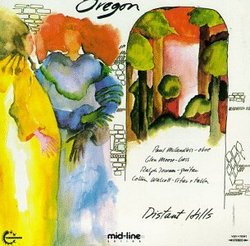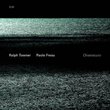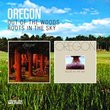| All Artists: Oregon Title: Distant Hills Members Wishing: 2 Total Copies: 0 Label: Vanguard Records Release Date: 10/25/1990 Genres: Folk, International Music, Jazz, Pop Styles: Jazz Fusion, Modern Postbebop, Bebop Number of Discs: 1 SwapaCD Credits: 1 UPC: 015707934121 |
Search - Oregon :: Distant Hills
 | Oregon Distant Hills Genres: Folk, International Music, Jazz, Pop
|
Larger Image |
CD DetailsSimilar CDs
|
CD ReviewsSublime country and eastern jazz A. Dutkiewicz | Norwood, South Australia Australia | 11/07/2003 (5 out of 5 stars) "I don't know if my title is quite accurate, but Oregon's music is simply gorgeous. You'd be stretched to find anything anywhere that compares with its beauty. Their early albums as a group are all a real treat, as are many of their solo albums (check out Towner and Walcott especially on ECM).Distant Hills was originally recorded in 1973. The instruments played by these master musicians give a clue to its musical content: Paul McCandless - oboe; Glen Moore - violin, flute, electric & acoustic bass, bowed bass; Ralph Towner: piano, trumpet, acoustic six and twelve string guitar; Collin Walcott - clarinet, piano, marimba, percussion, guitar, tamboura, sitar and tabla. Comparisons might be made with McLaughlin's My Goal's Beyond - similar territory and instrumentation anyway." A soul-lifting experience Richard Seegar | Miami, Florida | 06/06/2006 (5 out of 5 stars) "Two tracks on this album, Aurora and Canyon Song, are among my all-time favorites by anyone. Beautifully paced and building up to emotional waves that wash over you, this is true 'soul' music, a precurser to the best emotional highs the Pat Metheny Group can conjure up. The texures are exquisite, the musicianship suberb and the soloing always moves the piece forward." Where Third Ear Band could have gone had they not turned to mianfei | 11/15/2008 (5 out of 5 stars) "Although often thought of as being from a different genre of music, Oregon's "Distant Hills" might to the unacquainted be best described as the record Third Ear Band might have made after Abelard & Heloise had they not turned to synthesisers in the effort to gain more sales.
"Distant Hills", the second album by Oregon, can best be described, like Third Ear Band, as improvised acoustic folk music. The main focus of all the pieces is Ralph Towner's twelve-string acoustic guitar and Colin Walcott's percussion, which are accompanied by Paul McCandless on oboe and Glen Moore on bass to provide a quiet, yet far from bland and peaceful, rhythmic counterpart to the melodic lines of Towner and McCandless. Only on the third track, "Mi Chinita" is there anything approaching what most listeners would actually recognise as "jazz" and even there only for part of the piece - after which it turns into something distinctly quiet but intense and abstract. The opening piece, "Aurora" set a remarkable standard for the rest of "Distant Hills" with its simple groove that is dense owing to the range of instruments used yet at the same time very stark because the production manages to get the full sound out of the percussion in a way rarely seen in any type of music. Listening to "Aurora" now, one regrets that so many poor imitations have been much more successful at this ambient, world music-influenced style. Though quiet, the groove of "Aurora" is one of the most entrancing ever created and its repetitiveness serves to make it more interesting. "Dark Spirit" is extremely slow to the point of being depressing, yet Towner's twangy guitar line turns into one of the most amazing pieces of work you are likely to hear: so dense as to keep complete interest for the entire length of the track. The title piece combines the approach of the previous two to create a sense of "space" that is much, much greater than the name could suggest. "Canyon Song"'s opening oboe intro and barely audible guitar give way to a wonderfully sharp groove by Walcott that, though soft, has an intensity the most aggressive hard rockers could never match if they were serious. The way in which Walcott, Towner and Moore interplay is totally stunning even if one has to listen with the sharpest ear to notice what they manage. "Song for a Friend" is a twisted folk piece with a seemingly one-note guitar line moving the listener in a surprising way, whilst closer "Confession" returns to the ambient tone of "Aurora" with Oregon's expected skill and beauty. Although classed as jazz, Oregon's music, like Third Ear Band, was essentially improvised instrumental folk (and of course their records were originally released on folk label Vanguard). Still, words can hardly describe the unique sound of "Distant Hills": at times dense, and at times simple, these twisted folk pieces achieve a resonance and beauty uniquely their own." |

 Track Listings (7) - Disc #1
Track Listings (7) - Disc #1
